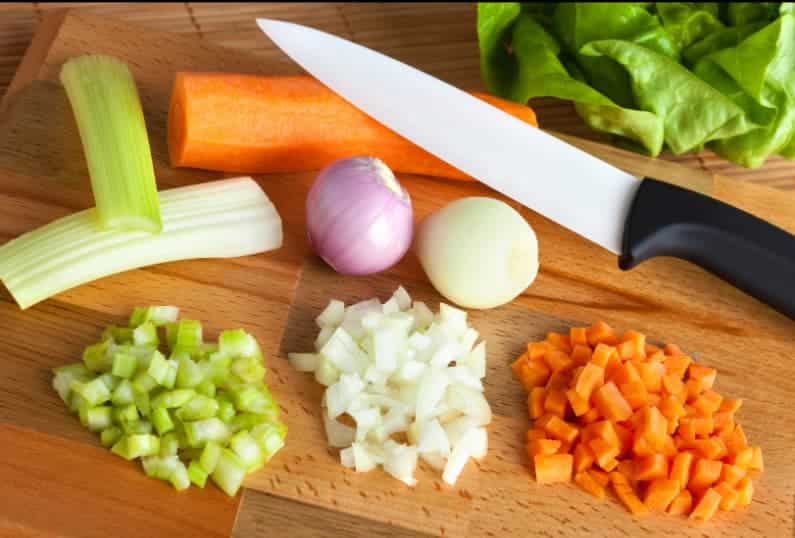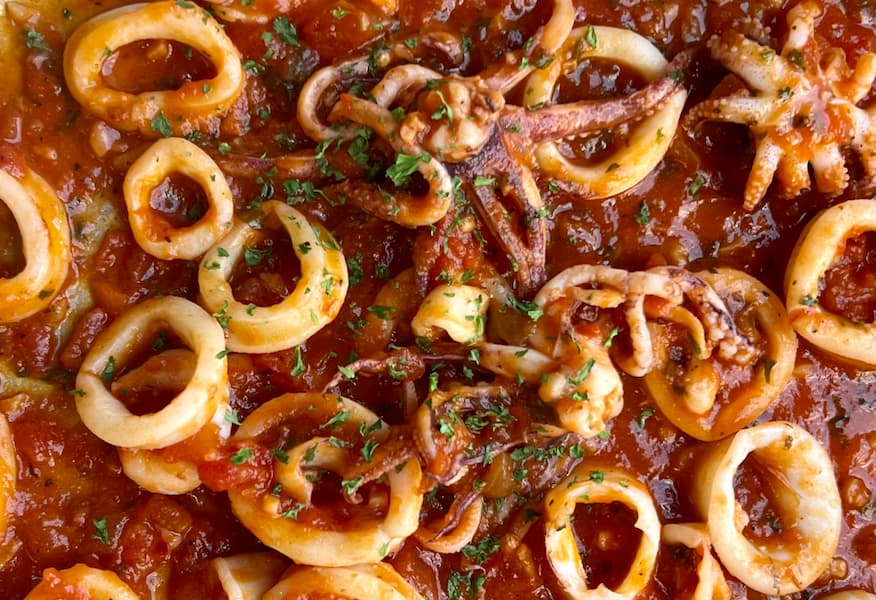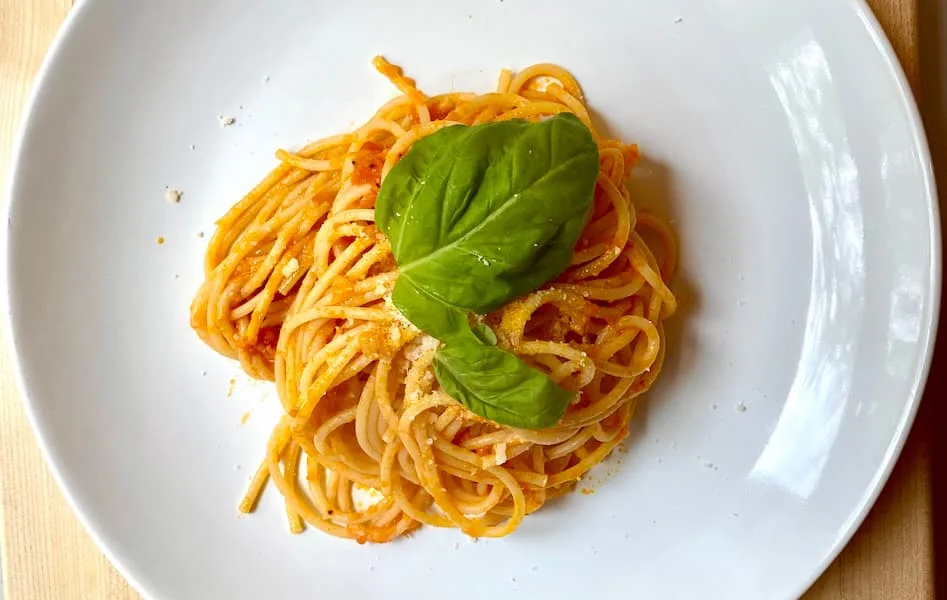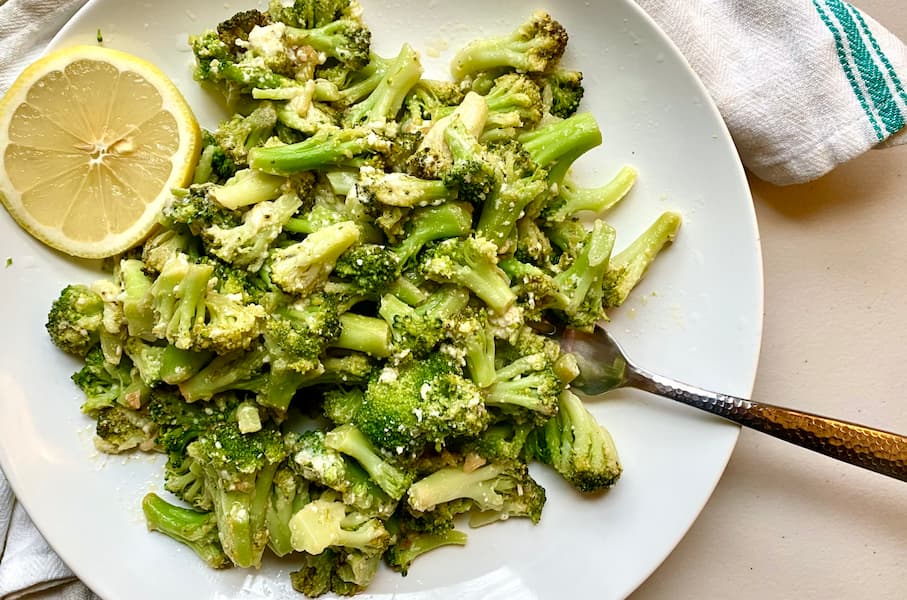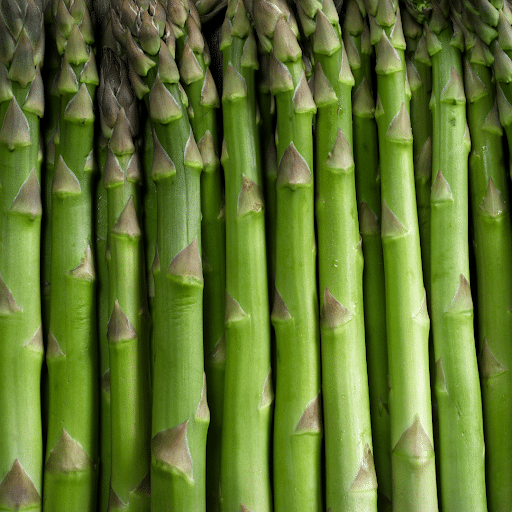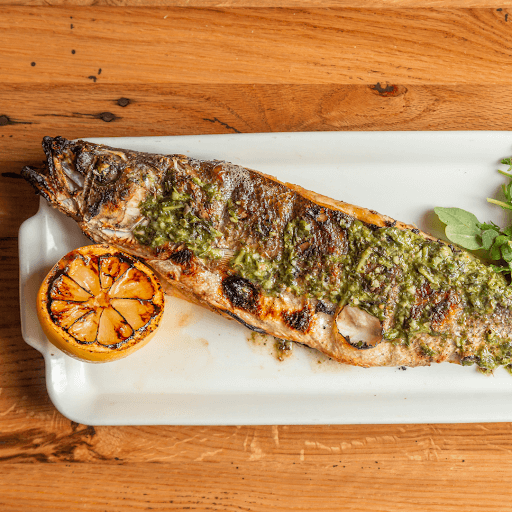In Italian cuisine, a soffritto is the base of countless recipes. It’s usually a mix of finely diced aromatic vegetables cooked down slowly in fat such as olive oil or butter. Although there are different variations of a soffritto depending on the country, a typical Italian soffritto recipe is made up of onions, celery, and carrots.
I’m about to show you just how easy it is to make an Italian soffritto that will add so much flavor to your favorite dishes.
I work in an Italian kitchen every day and I’ve been eating Italian food all of my life. And still… to this day… nothing is better than the smell of the classic soffritto recipe simmering on the stove. It reminds me of walking in the back door of my grandmother’s kitchen when I was a kid. I knew it was the beginning of a great tomato sauce.
At Mortadella Head we use it as a flavor base for a lot of our dishes. For example, it’s one of the main ingredients in our slow-cooked Bolognese sauce and many more pasta recipes and Italian dishes.
What does Soffritto mean?
“Soffritto” is an Italian word. It’s a noun derived from the verb “soffriggere” which means to slightly or slowly fry something.
It is similar to the Italian word “friggere” which means to deep fry something. An example of when you’d use the word “friggere” would be when you make french fries or fried fish.
Therefore, “soffritto” is what you get when you take certain fresh vegetables and slightly fry them in a pan on the stovetop.
Interesting Facts About Italian Soffritto Recipe
Universal Ingredient: Soffritto is often referred to as the “holy trinity” of Italian cooking, much like mirepoix in French cuisine or the “holy trinity” (bell pepper, onion, and celery) in Cajun cooking. It’s a fundamental base for many dishes, not just in Italy, but worldwide.
Etymology: The word “Soffritto” comes from the Italian verb “soffriggere” which means “to under-fry” or “to fry lightly”, referring to the gentle frying of the ingredients in olive oil.
Regional Differences: The composition of Soffritto can vary by region in Italy. For instance, in Tuscany, it’s common to add parsley, while in southern Italy, bell peppers or chili peppers might be included.
Versatility: Soffritto can be used in a myriad of dishes, from pasta sauces, soups, and stews, to risotto and many meat dishes. It provides a depth of flavor that makes it indispensable in Italian cuisine.
Preservation: Soffritto can be made in large batches and frozen for later use. Many Italian home cooks have a stash of Soffritto in their freezer to use whenever they need to quickly add flavor to a dish.
Cooking Time: Soffritto is traditionally cooked very slowly on low heat. This slow cooking process allows the flavors of the vegetables to meld together and form a savory base for many dishes.
Heritage: Soffritto has a long history, dating back to at least the Middle Ages in Italy. It’s a testament to the importance of simple, high-quality ingredients in traditional Italian cooking.
Ratio Importance: The 2:1:1 ratio of onion, celery, and carrot in Soffritto is significant, as it creates a balance of sweetness (from the onions and carrots) and slight bitterness (from the celery). This balance provides a depth of flavor that’s hard to achieve with any other combination.
Garlic Consideration: Even though garlic is a staple in Italian cooking, traditional Soffritto recipes don’t typically include it. However, it can be added depending on the final dish that the Soffritto will be used in.
Different Variations of Soffritto
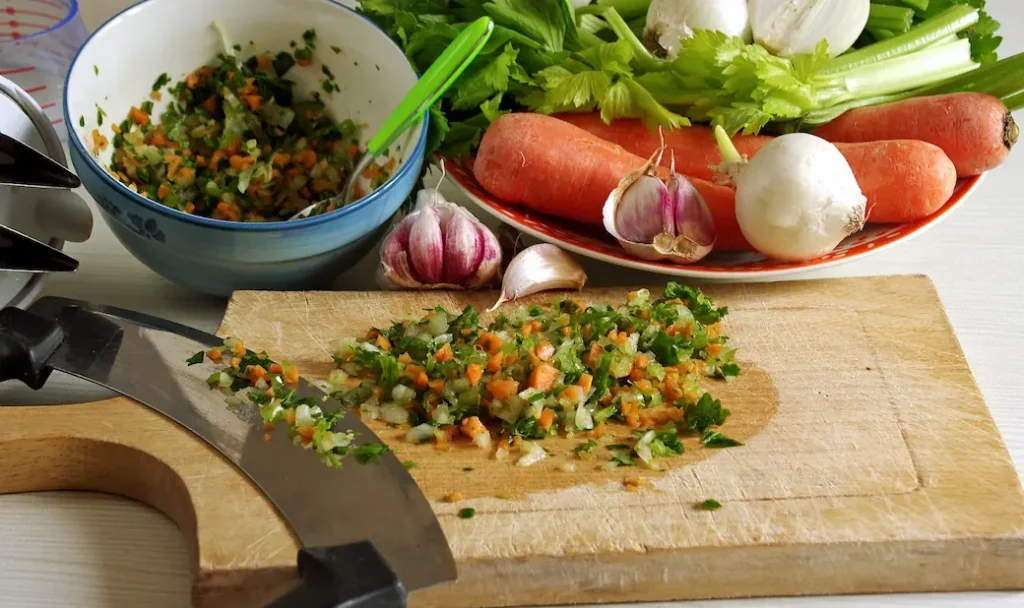
There is a different version of soffritto in almost every Mediterranean and Latin American culture. They are all a flavorful base made at the beginning of the cooking process for many recipes. Also, they all usually contain some parts celery, some parts onion, and other vegetables.
In France, they have the French mirepoix which is diced onions, celery, and carrots.
These are actually the same ingredients for our Italian soffritto recipe. The difference between mirepoix and soffritto is that the first one can be both stir-fried or served raw, while the latter must be necessarily slightly fried.
In Spain, they have their “sofrito” which is often onions, garlic, peppers, and tomato paste. And in Portugal, you’ll find “sofrito” with onions, garlic, tomatoes, peppers and spices.
In Louisiana, they have the Holy Trinity with onions, celery, and bell peppers.
Puerto Rico has onions, peppers, tomato, garlic, and cilantro in their sofrito.
Southern Italy makes their soffritto Napoletano, which you shouldn’t confuse with the traditional Italian soffritto. It’s a slow-cooked stew made with the lungs and other organs from the pig.
No matter where you go in the Mediterranean or Latin America, you’ll come across different types of sofrito. This aromatic mix is the perfect way to add flavor to any main dish.
What You Need to Make an Italian Soffritto
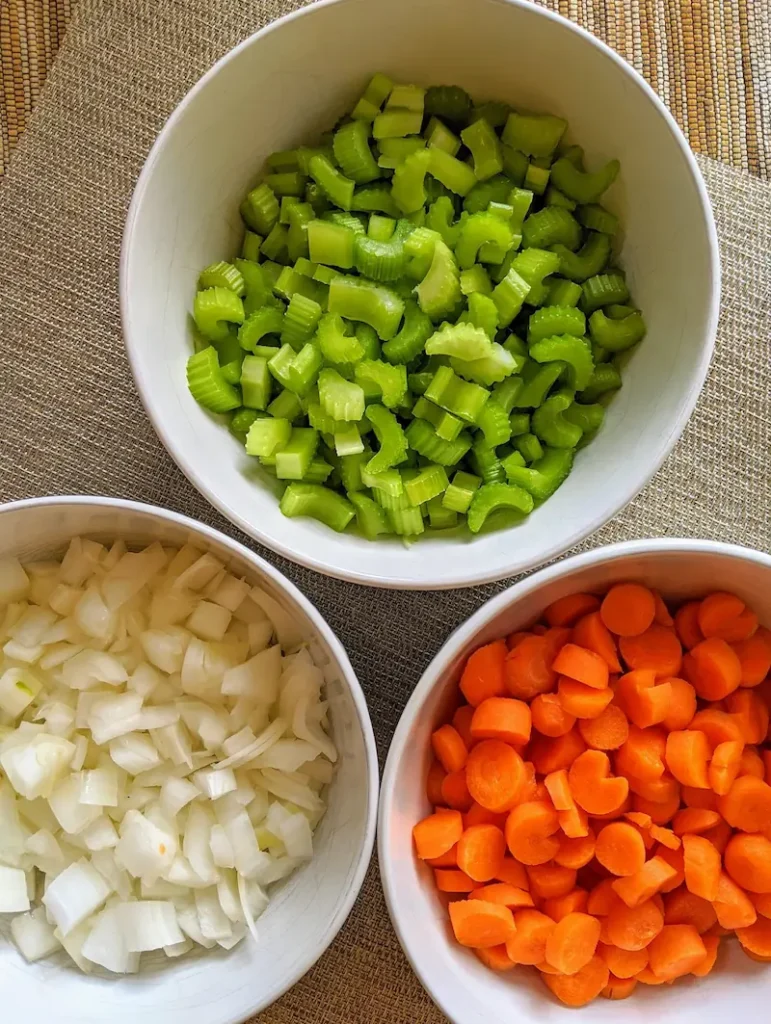
This traditional Italian soffritto recipe only needs a few simple ingredients. Everything can be easily found at your grocery store.
Onions: A yellow onion is commonly used for this recipe. However, if red onions are all you have they will work just fine.
Celery: One large celery stick is all you will need. You probably have a stalk of celery hanging around in your fridge already that you need to use up.
Carrot: It doesn’t really matter if you have large carrots or small carrots. They are getting chopped up anyway.
Olive Oil: You can use extra-virgin olive oil if you have it. If you have a lighter olive oil…use it.
Many people also like to add a little salt, black pepper, and white wine. I don’t usually do it, but feel free to add them if you want to.
Ingredients Variations
Italian Soffritto typically contains three base ingredients: onion, carrot, and celery in a 2:1:1 ratio. However, depending on the specific dish or regional variation, some cooks may add additional ingredients to their Soffritto. Here are a few variations you could consider:
Garlic: Some cooks add finely chopped garlic to their Soffritto. It can provide an extra layer of flavor but should be added near the end of the sautéing process to prevent it from burning.
Parsley or Parsley Stems: Adding chopped parsley or parsley stems can give your Soffritto a fresh, herbal flavor.
Bell Peppers: In some southern Italian dishes, diced bell pepper is added to the Soffritto mixture.
Tomatoes: Some variations of Soffritto include tomatoes. They are typically peeled, seeded, and finely chopped or crushed.
Fennel: Fennel can replace or be used in addition to celery. Its sweet, slightly anise-like flavor can add a unique twist to dishes.
Pancetta or Prosciutto: Some cooks like to add small amounts of diced pancetta or prosciutto to their Soffritto for a deeper, meaty flavor.
Chili Peppers: If you’re looking to add some heat to your dishes, finely chopped chili peppers can be added to the Soffritto.
Herbs: Depending on the dish, herbs such as rosemary, thyme, or bay leaves may be added.
Red or White Wine: After the vegetables have been sautéed and are softened, some cooks deglaze the pan with a bit of wine for added flavor.
Remember, the key to a good Soffritto is balancing flavors and knowing the dish you’re using it in. Always consider how the flavors of your Soffritto will complement the other ingredients in your recipe.
How to make an Italian Soffritto
Here comes the fun part. The first step in making a good soffritto is to dice everything up into small pieces. I’m talking about really small pieces. You want the vegetables to be finely diced or minced. The smaller the better in my opinion.
How to dice the vegetables
I think that a soffritto is something you shouldn’t even know is there. It should just disappear into the other ingredients of the recipe.
If you have a food processor you can use it to chop everything up. It will be fast and will get everything chopped up nice and small.
You can also use a cheese grater. Sometimes I will grate my carrots and onions on the smaller holes of the cheese grater when I want them to be completely incorporated into a dish like sugo di pomodoro or risotto recipes.
Anyway, my favorite way to prepare my fresh vegetables for a soffritto is to do it by hand using a really sharp knife. To me, there is something deeply satisfying about chopping fresh vegetables.
It’s almost like meditation. I block everything else out and just focus on getting the perfect-sized diced vegetables.
How to stir-fry soffritto
Now put a dutch oven, heavy pot, or saucepan on medium-low heat. Add generous amounts of olive oil to the pan and put in your diced vegetables.
At this point in time, you can add some salt and black pepper. Not only will the salt add flavor, but it will pull the moisture out of the diced vegetables and assist in the caramelization process.
Let it all cook slowly and keep moving it around the pan with a wooden spoon. This will prevent it from sticking to the bottom of the pan and burning.
A good soffritto takes time…so don’t rush it. You’ll know when it’s done because you’ll be able to smell the aroma of cooked vegetables. The carrots and celery will become soft and the onions will be golden brown.
What to do with your Italian Soffritto
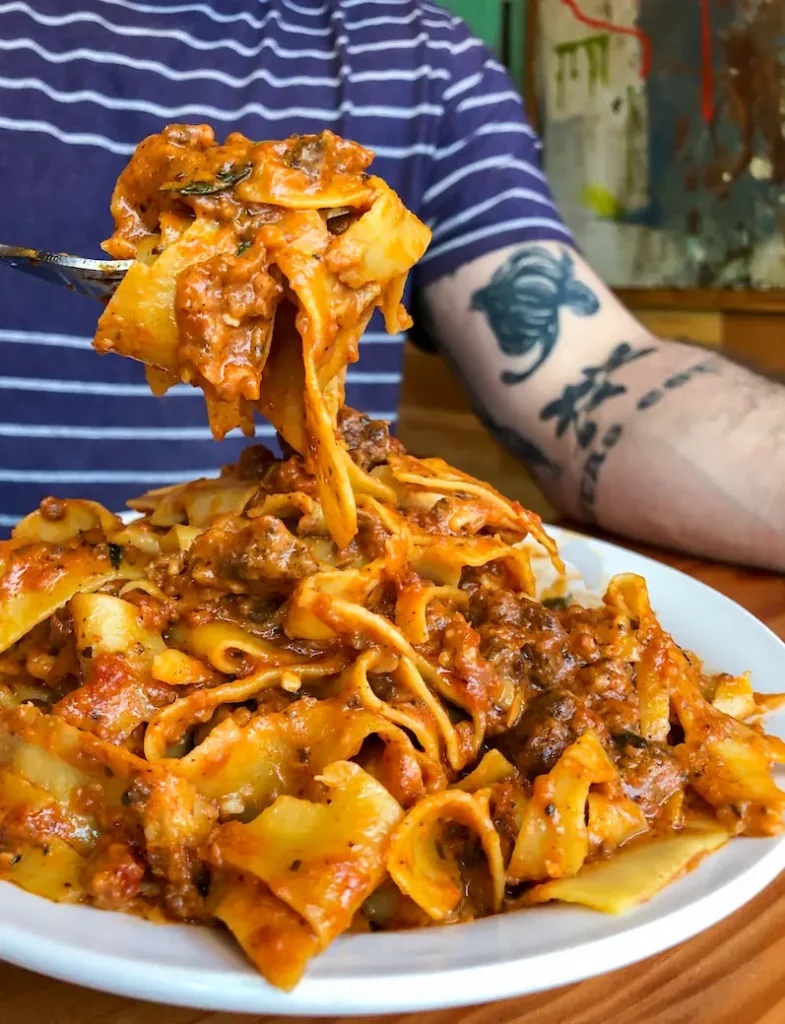
Now, what can you do with the Italian soffritto you just made? It’s used in so many different Italian recipes and can be used any time of year.
The most common way to use it is to make ragouts and meat sauces, like bolognese sauce. There’s a lot of them: duck ragout, wild boar ragout, turkey ragout… Name one type of meat and there’s a ragout recipe for it. Which almost certainly includes soffritto. You can also just let it simmer for a few minutes in tomato sauce with a couple of minced sausages, and you’ll get an amazing dressing for any type of dry pasta.
Soffritto is also used to make the worldwide famous risotto alla milanese. Alternatively, there’s a delicious soup from Tuscany called Garmugia that you should definitely look up to.
And finally, you can use it to make a tasty brown stock for the next time you roast some chicken or veal.
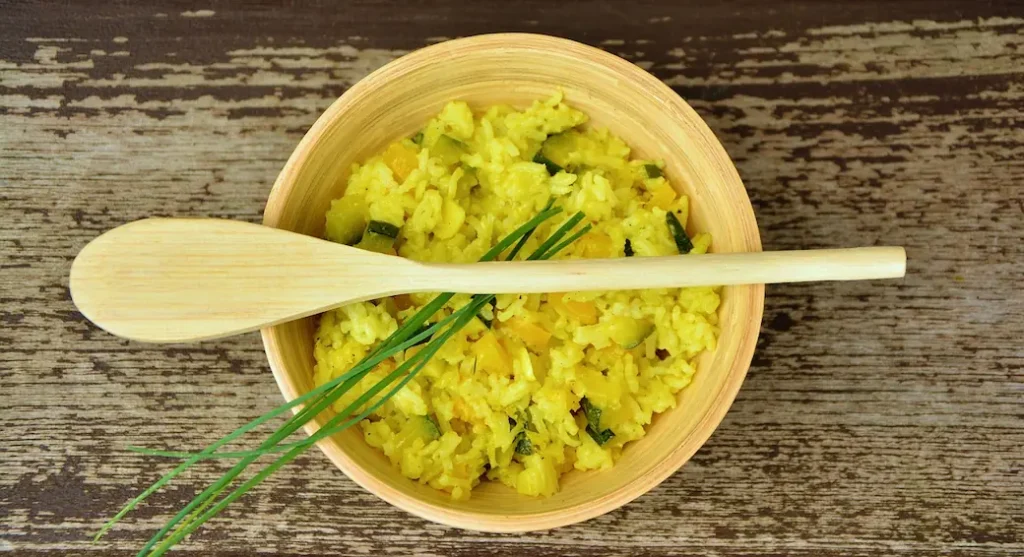
Here’s a trick that a lot of Italian chefs use to cut down on the preparation time of many dishes. You make a big batch of soffritto in advance so you have it ready for quick pasta sauces, pasta e fagioli, and lots of other Italian cooking.
You can store it in an airtight container and freeze it for later use. Some people will freeze it in an ice cube tray so they have smaller portions ready to use.
Then you can add additional ingredients to the basic soffritto depending on the recipes you need to make.
Things that can be added to your soffritto mix to enhance the flavor are: Calabrian chili flakes, bay leaves, fresh basil leaves, Italian parsley, tomato paste, garlic cloves, and dried aromatic herbs.
So get a large frying pan, put it on medium heat with some high-quality extra virgin olive oil, and make a batch of Italian soffritto.
Italian Soffritto Recipe FAQs
Q: Can I make Soffritto in advance?
A: Yes, Soffritto can be made in large batches and then stored in the fridge for up to a week or frozen in small portions for up to six months.
Q: Can I use Soffritto as a base for any dish?
A: While Soffritto is commonly used as a flavor base in many Italian dishes, it can also be used in a variety of cuisines. It adds a rich, savory depth to soups, stews, sauces, and more.
Q: Can I use any type of onion for my Soffritto?
A: Yellow onions are traditionally used in Soffritto because they have a nice balance of sweetness and astringency, and they caramelize well. However, you can also use white or red onions, depending on your preference or what you have on hand.
Q: Is there a specific order in which to add the vegetables?
A: Typically, the onions are added first as they take the longest to soften. The carrots and celery are then added. If you’re using garlic, it should be added last to prevent it from burning.
Q: What’s the difference between Soffritto and Battuto?
A: Battuto is the raw version of Soffritto, comprised of the same ingredients – onion, carrot, and celery, and sometimes garlic or parsley – finely chopped. When this mixture is sautéed in oil or fat, it becomes Soffritto.
Q: Why is my Soffritto bitter?
A: Soffritto can become bitter if it’s cooked on too high heat or for too long. It’s meant to be cooked slowly on low heat until the vegetables are softened.
Q: Can I use vegetable oil instead of olive oil?
A: Olive oil is traditionally used in Soffritto for its flavor. However, if you prefer, you can use vegetable oil. Keep in mind that it may slightly alter the taste of your Soffritto.
Q: Is Soffritto healthy?
A: Soffritto is made up of vegetables and olive oil, all of which have health benefits. However, like any food, it should be consumed as part of a balanced diet.
Q: What can I do if I made too much Soffritto?
A: If you have leftover Soffritto, you can store it in the fridge for up to a week, or freeze it in small portions in airtight containers or ice cube trays for up to six months. It can then be added straight from the freezer into your dishes.
Italian Soffritto Recipe Card
That was all you need to know to master this easy Italian soffritto recipe. Now all you have to do is get to the kitchen and make as much as you can to flavor up all your favorite dishes. Have fun!
Print
Easy Italian Soffritto
- Author: Mortadella Head
- Total Time: 30 minutes
- Yield: 1 batch 1x
Description
In Italian cuisine, a soffritto is the base of countless recipes. Here’s how to make one that will add an amazing flavor to your favorite dishes.
Ingredients
1 carrot
1 celery stalk
1 onion
Extra-virgin olive oil to taste
(optional) salt and black pepper to taste
(optional) 2 oz white wine
Instructions
- Dice everything up into small pieces. The smaller the better.
- Put a dutch oven, heavy pot or saucepan on medium-low heat and add generous amounts of olive oil.
- Put in your diced vegetables.
- Add the optional salt, pepper and white wine and stir.
- Let it cook slowly while stirring frequently with a wooden spoon to make sure that the vegetables don’t stick to the bottom of the pan.
- When the celery and carrot have become soft, and the onion is golden brown, move the soffritto away from the fire and either store it in the freezer or use it immediately for your next tomato sauce or risotto recipe.
- Prep Time: 15
- Cook Time: 15
- Category: Vegetarian, aromatic base
- Method: Stir-frying
- Cuisine: Italian
Nutrition
- Serving Size: 1 batch
- Calories: 155 kcal
- Sugar: 3.8 g
- Sodium: 58 mg
- Fat: 13.8 g
- Saturated Fat: 2.01 g
- Carbohydrates: 3.8 g
- Fiber: 1.4 g
- Protein: 1 g

